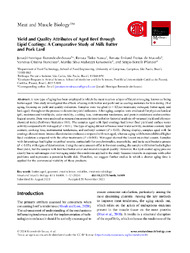Yield and quality attributes of aged beef through lipid coatings: a comparative study of milk butter and pork lard.
Yield and quality attributes of aged beef through lipid coatings: a comparative study of milk butter and pork lard.
Author(s): REZENDE-DE-SOUZA, J. H.; NASSU, R. T.; MACEDO, R. E. F. DE; FRANCISCO, V. C.; KARWOWSKI, M. S. M.; PFLANZER, S. B.
Summary: A new type of aging has been employed in which the meat receives a layer of fat prior to aging, known as being butter-aged. This study investigated the effects of using milk butter and pork lard as coating materials for loin during 28-d aging, focusing on yield and quality indicators. Samples were weighed (n=12 per treatment; wet-aged, butter-aged, and lard-aged) throughout the process to determine yield indicators. After aging, samples were evaluated for physicochemical (pH, moisture and total lipids, color stability, cooking loss, instrumental tenderness, and protein oxidation) and microbiological counts. Data were analyzed as repeated measures in time (color) or factorial analysis of variance (yield and physicochemical traits) (Software Statistica 10.0). The samples aged with lipid coatings had lower final yield and surface water activity compared with wet-aged (P<0.01). The type of aging did not influence inner water activity, moisture content, lipid content, cooking loss, instrumental tenderness, and carbonyl content (P>0.05). During display, samples aged with fatcoatings showed more intense discoloration (redness) compared with wet-aged, whereas aging with butter exhibited higher lipid oxidation compared with the other treatments (P<0.001). Wet-aged showed the lowest microbial counts. Samples with fat coatings had higher microbial counts, particularly for psychrotrophic, mesophilic, and lactic acid bacteria groups (P<0.05), with signs of deterioration. Using the same amount of fat in the meat coating, the sample with butter had a higher final yield, but the sample with lard had better color and microbiological quality. However, the lipid-coated aging process clearly has no advantages over wet aging under the conditions applied to the study because it results in exposure with color problems and represents a potential health risk. Therefore, we suggest further studies in which a shorter aging time is applied for the commercial viability of these products.
Publication year: 2024
Types of publication: Journal article
Keywords: Butter-aged, Gourmet, Meat microbiology, Meat science, Volatiles
Observation
Some of Embrapa's publications are published as ePub files. To read them, use or download one of the following free software options to your computer or mobile device. Android: Google Play Books; IOS: iBooks; Windows and Linux: Calibre.
Access other publications
Access the Agricultural Research Database (BDPA) to consult Embrapa's full library collection and records.
Visit Embrapa Bookstore to purchase books and other publications sold by Embrapa.

